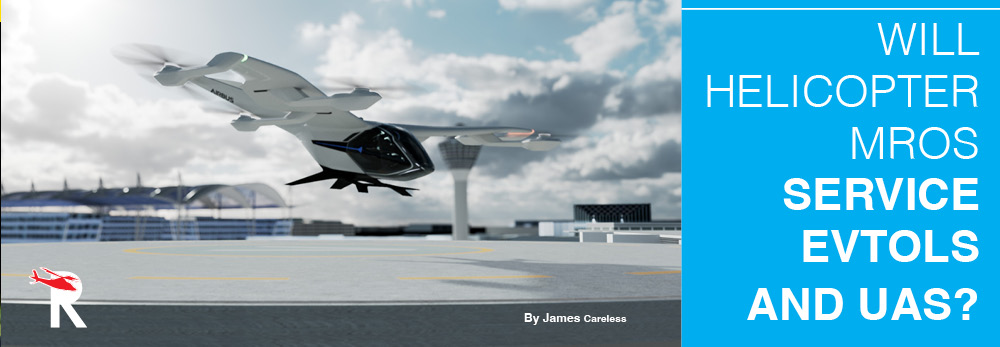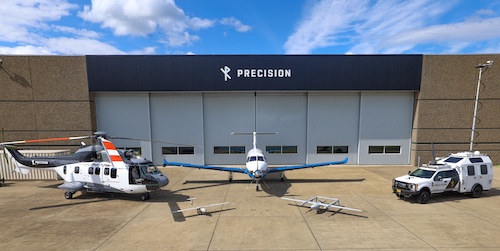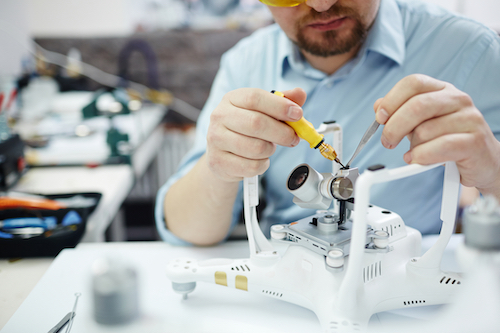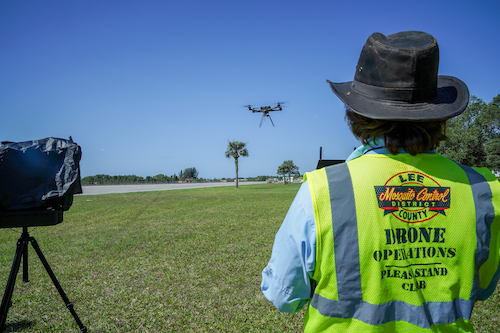|
Apr
17
2023
|
|
Posted 2 years 256 days ago ago by Admin
|
|

The rotorcraft industry is expanding its embrace beyond helicopters to include electric vertical takeoff and landing aircraft (eVTOLs) and unmanned aerial systems (UAS or unmanned aerial vehicles/UAVs), as reflected by this magazine’s rebranding to Rotor Pro.
This is a change with wide-ranging implications for the entire helicopter industry, including maintenance, repair and overhaul (MRO) service providers. Just like helicopters, eVTOL and UAS aircraft will need to be maintained and repaired over time.
So what does this mean to the helicopter MRO sector? To find out, Rotor Pro queried a variety of MRO-related service providers.
Three uniquely different service providers shared their insights on the subject: Airbus Urban Air Mobility (UAM), the Lee County (Florida) Mosquito Control District, and Precision Integrated Programs. Here’s what they had to say about the impact of eVTOLs and UAS on the helicopter MRO market.
The Players
Located in Munich, Germany, Airbus UAM is part of the Airbus group of fixed-wing and rotary-wing companies. It is focussed on bringing the CityAirbus NextGen eVTOL four-seat urban aerial vehicle to market.
Given its own interest in the eVTOL market, Airbus is ready to provide MRO services to these aircraft once they enter service. And it has the resources to do so. Francois Le Marechal, Airbus UAM’s head of products and services said, “Airbus Helicopters has a world-wide network of 31 customer centers and affiliated sites, which offers services to our global customer base. This covers our entire product line and the complete range of MRO services. It is a huge asset for supporting future eVTOL operators globally. In addition to that, we also have a significant MRO footprint with Airbus Commercial and its subsidiaries like SATAIR that we can leverage.”
In contrast, the Lee County Mosquito Control District fights mosquito infestations in its region using a range of tools including fixed-wing and manned/unmanned rotorcraft for surveillance and pesticide applications. “The MRO facility at Lee County Mosquito Control District is responsible for all general inspections and repairs of our fleet of aircraft; Airbus H125, DC-3TP, and King Air TC-12B (A200C),” said Nick Lefkow, the District’s lead UAS pilot. While we no longer perform our own component overhaul, most routine maintenance can be completed in-house, including avionics inspections, installations and repairs.”
This MRO facility also services the district’s drones. “We perform most maintenance on our UAS in-house, but if the nature of the job demands more experience we opt to ship it back to the manufacturer for repairs,” Lefkow said. “Our avionics team has lots of experience dealing with the small wiring components that’s very similar to what is on board most UAS these days. Some of our staff even have personal experience toying with drones in their spare time at home and came to us with a fair amount of experience working on their own unmanned aircraft.”
The Lee County Mosquito Control District’s UAS fleet started when the LCMCD acquired a DJI Phantom 4 Pro. “This is the platform that both accumulates the most airtime and thus requires the most service,” said Lefkow. “The Phantom is flown as an inspection vehicle prior to … sending out our autonomous drone designed to spread granular materials into the water to kill mosquito larvae.”

The autonomous drone Lefkow is referring to is the large PrecisionVision 35 (PV35) made by Leading Edge Aerial Technologies. “All of the maintenance that has been required for the PV35 has occurred in-house by the UAS Department, though if any larger repairs would have been necessary, we likely would outsource that back to the manufacturer, with whom we have a strong working relationship,” he said. “We’ve also recently purchased a Freefly Alta X this past year (a large drone capable of mapping with a LiDAR & RGB camera payload) and similarly will take on most of the maintenance required within the UAS Department.”
The third player in this article is Precision Integrated Programs, which provides a range of manned and unmanned aerial services to customers from the company’s base in McMinnville, Oregon. In addition to UAS vehicles such as Lockheed Martin’s Stalker Block 25 and Stalker VXE30, Aerovel Flexrotor, AeroVironment Puma, and Insitu’s ScanEagle, Precision’s fleet includes multiple rotorcraft such as the Eurocopter AStar, Bell 205, Guimbal Cabri G2, and Super Puma, plus fixed-wing aircraft such as Cessnas and the Pilatus PC-12.
“We perform maintenance in-house unless there is a significant repair needed that can only be completed by the OEM, such as depot-level maintenance on items like engines, cameras, and other payloads,” said Emma Ballantyne, who heads up Precision’s Contracts and Programs department. “Our maintenance professionals are also unmanned operators due to being cross-trained.”
To Service or Not to Service?
There is undoubtedly an opportunity for helicopter service organizations to make money servicing eVTOL and UAS aircraft. But the three companies interviewed differed on whether this is an opportunity worth seizing.
For Airbus’ Le Marechal, expanding his company’s traditional helicopter MRO services to include eVTOLs and UAS is a no-brainer. “There are different business models possible. Airbus could service the vehicles, the operators could do it themselves or it could be a joint approach,” he said. “Which model will be applied depends on the operator’s requirements and the local conditions. CityAirbus NextGen is designed for simplicity, so any MRO work will not require a high effort in any case.”
Precision Integrated Programs has already grasped this opportunity when it comes to UAS. “Our unmanned company operates and maintains UAVs both for their customers and the assets they personally own,” said Emma Ballantyne. “Our customers range from commercial to government agencies, such as Lockheed Martin, the U.S. Department of the Interior’s Bureau of Land Management, the U.S. Forest Service, the United States Special Operations Command, the U.S. Marine Corps, and other Department of Defense agencies.”

Conversely, Lee County Mosquito Control District’s Lefkow does not see possibilities in servicing other people’s UAS aircraft. “We are a government agency with a very specific mission to protect public health by controlling mosquito populations throughout the county,” he said. “LCMCD’s MRO facility only services our own fleet; we are not open to the public.”
Lefkow added that most of the UAS maintenance that is required for LCMCD’s systems can be completed by members of the UAS Department, though they have utilized the experience of the district’s avionics team to repair small internal components.
Preparing for eVTOL/UAS Servicing
While eVTOLs and UAS have much in common with conventional helicopters, they are sufficiently different to require MROs to adjust to support them fully. “New skills in electrification will need to be developed and matured to ensure such new MRO services,” said Le Marechal. Lefkow said, “A strong set of fine tools for the tiny hardware packed into such small spaces is a must. Short of that, a lot of patience and diligent notetaking is helpful in dealing with the internal components.” He added, “Here at LCMCD, we do not expect the addition of UAS to have any negative impact on our helicopter MRO facility. Our aircraft mechanics have a primary objective of keeping the manned aircraft safe and operational. This will always remain their priority as far less will be accomplished by having a helicopter down for maintenance than having a UAS down.”

So how will helicopter MROs adapt to servicing eVTOLs and UAS? Le Marechal at Airbus said, “We have some specialized centers that could be leveraged across the group, such as SATAIR who is a leader in aviation battery services. “When the time comes, we will forward-fit our infrastructures, properly equip them and provide our collaborators with the right training and documentation to enable the safe and optimal entry into service of CityAirbus NextGen.”
At Precision, Ballantyne expects their unmanned service division to remain focussed on UAS, rather than sharing the work with their manned division as demand grows. “The maintenance is on a smaller scale because we operate Group 1 - Group 3 UAVs, which require a slightly different knowledge base,” she said. “The maintenance of large UAVs, such as Group 5 does require work that resembles that of an A&P's skill set. It is always an option to reconsider the services that can be provided by our companies, but for us because we have a dedicated unmanned company, it would be unnecessary. For us, it is always best to employ people who have experience with UAVs, especially if they are performing maintenance.”
Worth noting: The other aspect to UAV maintenance is field maintenance and troubleshooting, which happens often whenever Precision’s field service representatives (FSRs) are deployed. “All of our FSRs are cross-trained so that they can operate and maintain the aircraft,” said Ballantyne. “This is a huge benefit to the footprint of our deployed groups and it also provides well rounded operators who do not have to rely on a separate person or company when maintenance cycles or issues arise.”
As for the future? “As UAVs and eVTOLs become more common, dedicated unmanned maintenance professionals, contractors and companies may arise,” Ballantyne told Rotor Pro.
Yet, multiple platform operators such as Airbus will see advantages in supporting helicopters, eVTOLs, and UAS from common MRO facilities. “Easy maintenance in close proximity will be an asset for eVTOL operators,” said Le Marechal. “It needs to be carried out in a cost- and time-efficient way in order to ensure a smooth market entry for our CityAirbus NextGen. This is our main focus. Classic helicopters and eVTOLs will coexist for quite a long time, as the more robust missions for VTOLs currently can’t be performed by eVTOLs,” he said. “Therefore, the maintenance business for both types of aircraft will be complementary.”
The bottom line: The future of rotorcraft MROs is definitely moving to a multi-platform universe as eVTOLs and UAS find their roles in the traditional helicopter marketplace. Since both new platforms are extending rotorcraft service into areas not fully served by manned helicopters, this should result in additional work for these MROs over time.
READ MORE ROTOR PRO: https://justhelicopters.com/Magazine
WATCH ROTOR PRO YOUTUBE CHANNEL: https://buff.ly/3Md0T3y
You can also find us on
Instagram - https://www.instagram.com/rotorpro1
Facebook - https://www.facebook.com/rotorpro1
Twitter - https://twitter.com/justhelicopters
LinkedIn - https://www.linkedin.com/company/rotorpro1